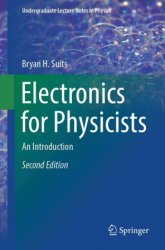Electronics for Physicists: An Introduction (2nd Edition)
- Добавил: literator
- Дата: 1-09-2023, 16:19
- Комментариев: 0
 Название: Electronics for Physicists: An Introduction (2nd Edition)
Название: Electronics for Physicists: An Introduction (2nd Edition)Автор: Bryan H. Suits
Издательство: Springer
Год: 2023
Страниц: 340
Язык: английский
Формат: pdf (true), epub
Размер: 25.5 MB
This book provides undergraduate physics majors and students of related sciences with a sound understanding of basic electronics and how it is used in the physical sciences. While today few science students go on to careers that demand an ability to design and build electronic circuits, many will use and rely on electronics. As scientists, they will require an appropriate level of fundamental knowledge that enables them, for example, to understand what electronic equipment is doing, to correctly interpret the measurements obtained, and to appreciate the numerous links between electronics and how it is practiced and other areas of science. Discussing electronics in the broader context and from the point of view of the scientist, this book is intended for students who are not planning to become electronics specialists but who will use electronics. It has been written in a relatively informal style and includes many detailed examples, as well as some “outside the box” material, including some ideas from quantum computing, to inspire thought and creativity. A selection of relevant exercises is included at the end of each chapter.
Physicists rely heavily on electrical instrumentation to measure physical phenomena. There was a time, not long ago in history, when it was normal for a physicist to routinely design and construct their own electrical instrumentation. While there are exceptions, in general, this is no longer the case; design and construction of most electronic instrumentation is left to specialists and engineers. However, a physicist, whether an experimentalist or theorist, will need some understanding of the basics of electronics and how the equipment works in order to fully understand and evaluate the results of measurements, and possibly in order to troubleshoot and make simple repairs. Much of this understanding must first come from a knowledge of the language of electronics—the lexicon as well as the symbolic representation of circuits using schematic diagrams. This book was written for use as an undergraduate physics text with such future use in mind. The details necessary for quality engineering design are generally excluded here in favor of a basic and practical understanding of what is going on.
A second utility of electronics in the physics curriculum is that many ideas and problem-solving strategies show up that are also used in other areas of science. Indeed, electrical analogies are often used as an explanation for situations that have little to do with electronics. One prime example of cross-use is the appearance of imaginary numbers. Imaginary numbers show up in all areas of science and engineering that include periodic signals. In addition to electronics, those areas include studies of vibration, including seismometry, acoustics, optics, radio and radar, and even “brain waves.” It is important to understand how to use and interpret imaginary numbers since, after all, by definition no real measurement will ever give you an imaginary result. Other overlapping topics include resonance, solutions of linear equations, and the use of linearized models.
Each electronics instructor will have their own idea about what is most important. That cannot be helped. What is presented here represents my priorities. Based on my perspective and experience as a physicist and teacher of electronics, I chose introductory topics and problems that I find most interesting and potentially useful. There is, however, more in this book than can possibly be covered in a single semester course. Anyone using the book as a course textbook, in whole or in part, should feel free to skip those topics that do not match their interests.
Any electronics course would be expected to include a laboratory component. In fact, some of the material here originated as background material for such a laboratory experience. It is recognized that each instructor has their own laboratory priorities, and possibly a limited or specialized supply of laboratory equipment for such a purpose. It is hoped that the presentation here is written in a manner suitable for use in either the laboratory or classroom. The first obvious examples of laboratories that appear here are the sections related to the Wheatstone and Kelvin bridges, both of which originated primarily as laboratory exercises. Along with the material in the last chapter, some practical experience using an embedded microcontroller—that is, some programming—is definitely useful. Programming varies from device to device and is not really “electronics,” and so it is only included here in a very general way.
The book includes three broad categories of electronics. Chapters 1–5 cover passive linear electronics, Chaps. 6–11 look at nonlinear and active devices including diodes, transistors, and op-amps, and Chaps. 12–14 consider the basics of digital electronics and simplified computers.
Скачать Electronics for Physicists: An Introduction (2nd Edition)
Внимание
Уважаемый посетитель, Вы зашли на сайт как незарегистрированный пользователь.
Мы рекомендуем Вам зарегистрироваться либо войти на сайт под своим именем.
Уважаемый посетитель, Вы зашли на сайт как незарегистрированный пользователь.
Мы рекомендуем Вам зарегистрироваться либо войти на сайт под своим именем.
Информация
Посетители, находящиеся в группе Гости, не могут оставлять комментарии к данной публикации.
Посетители, находящиеся в группе Гости, не могут оставлять комментарии к данной публикации.
